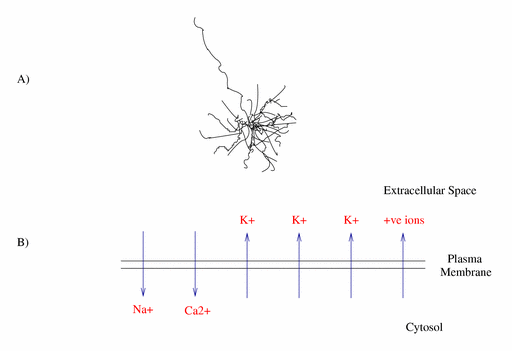Fohlmeister, Miller, 1997
Model Status
This is the original unchecked version of the model imported from the previous CellML model repository, 24-Jan-2006.
Model Structure
The ganglion cells present in the vertebrate retina form the only pathway by which the retina and the brain communicate. These output neurons translate the post-synaptic potentials into a pattern of impulses whose frequency is regulated by the synaptic current. Voltage-clamp studies of retinal ganglion cells have suggested that there are at least five different ionic currents present, namely: INa ; ICa ; the non-activating, delayed rectifier IK ; inactivating IK,A ; and calcium-activated potassium currents IK,Ca . In 1990, Fohlmeister et al. developed a mathematical model of ganglion cell impulse generation which was based on these five ionic currents. The first four currents were modelled as being voltage-gated, while the fifth current, IK,Ca , is gated by [Ca2+]i. The basic mathematical structure of the model is based on the Hodgkin-Huxley style of cellular modelling (see The Hodgkin-Huxley Squid Axon Model, 1952 for more details).
This 1990 model appeared to provide a reasonably accurate representation of both the impulse waveform and repetitive firing behaviour of ganglion cells in the tiger salamander retina. Model simulations suggested that IK,Ca might play an important role in stabilising the cell (i.e. preventing spontaneous firing), and also in regulating the interspike period. To improve their understanding of this mechanism, in 1997, Fohlmeister and Miller combined new whole-cell experimental data together with pharmacological information and computer modelling to provide an integrated view of the experimental results, analysis, and simulation (see the figure below for a schematic diagram of their model).
Model simulations suggested that ICa and IK,Ca do play an important role in controlling impulse frequency. But although this single compartment model was regarded as being qualitatively accurate in simulating impulse frequency behaviour and its underlying mechanisms, model limitations arose due to a lack of morphological data. This issue was addressed in a detailed, multicompartmental model of the ganglion cell, which was published in a companion paper.
The complete original paper reference is cited below:
Impulse Encoding Mechanisms of Ganglion Cells in the Tiger Salamander Retina, J. F. Fohlmeister and R. F. Miller, 1997, Journal of Neurophysiology , 78, 1935-1947. (Full text (HTML) and PDF versions of the article are available on the Journal of Neurophysiology website.) PubMed ID: 9325362
 |
| A schematic illustration showing: A) a ganglion cell with its axon projecting upwards and its numerous dendrites projecting out from the soma; and B) the ionic currents across the plasma membrane of the cell. |

